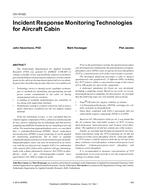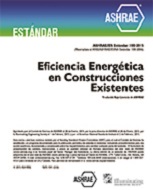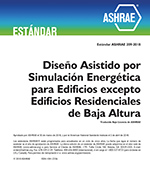Description
The Netherlands Organization for Applied ScientificResearch (TNO) was granted by ASHRAE (1306-RP) toconduct scientific review and feasibility analysis of technologiesand methods for measuring aircraft power system contaminantsin the cabin air during unanticipated adverse incidents.In particular, the following specific objectives were addressed:
- Technology review to identify novel candidate technologies or methods for identifying and quantifying aircraft power system contaminants in the cabin air during unanticipated adverse incidents
- A ranking of available methodologies for suitability of use along with supporting rationale
- Performance testing to evaluate sensitivity and accuracy under laboratory conditions for the two highest ranked methods
From the technology reviews, it was concluded that forvolatile organic compounds (VOCs), froman economical pointof view, passive sampling has an advantage and that passivesampling may fulfill the boundaries for air sampling in aircraftcabins.For monitoring organophosphate esters, we concludedthat a polydimethylsiloxane-(PDMS) based solid-phasemicroextraction (SPME) is most promising. It can be appliedfor monitoring qualitatively, but in order to quantifycompoundsuptake rates have to be determined experimentally.Organophosphate esters can also be monitored in an activeway with the use of passive air sampler XAD-2 in combinationwith a quartz filter, followed by analysis with gas chromatographywith a flame photometric detector (GC/FPD) in phosphorusmode or gas chromatography-coupled massspectrometry (GC/MS) in single-ion mode.Prior to the performance testing, the analytical procedurewas developed and validated for the determination of organophosphateesters (OPEs) and, in special tricresyl phosphates(TCPs), a neurotoxicant, if tri-ortho-cresyl isomer is present.The developed analytical procedure is able to analyzequantitatively and qualitatively 23 different OPEs includingfive TCP isomers within a concentration range in the extractof 0 to 400 ng/mL for most of the compounds.
A dedicated simulation for bleed air was developed,including a sampling system. Based on our work, we recommendapplying active sampling. For this purpose, we concludethat the following types are well suitable and accurate:
- Tenax® GR tubes for organic volatiles as toluene
- 2,4-Dinitrophenylhydrazine (DNPH) cartridges for volatile carbonyls as formaldehyde
- Glass filter combined with XAD-2 absorption tube for semivolatile organic compounds (SVOCs) as OPEs
Based on GC-MS analysis of the jet oil, it was found thatthe oil contains four detectable isomers of TCP: tri-meta,meta-meta-para, meta-para-para, and tri-para cresyl phosphate.The applied jet oil did not contain any ortho isomers.Finally, we conclude that the fume developed by the simulationexperiments using the TCP-containing jet oil did notcontain tri-ortho-cresyl phosphate (ToCP), while four differentTCP isomers could be found in both the jet oil and in thefume: tri(meta)-cresyl phosphate; tri(meta-meta-para)-cresylphosphate; tri(meta-para-para)-cresyl phosphate andtri(para)-cresyl phosphate.
It is recommended to measure concentrations of TCPcontaminants in an event aircraft to test the proposed methodologyin a future study.
Citation: ASHRAE Transactions – Volume 121, Part 1, Chicago, IL
Product Details
- Published:
- 2015
- Number of Pages:
- 14
- File Size:
- 1 file , 1.2 MB
- Product Code(s):
- D-CH-15-022




